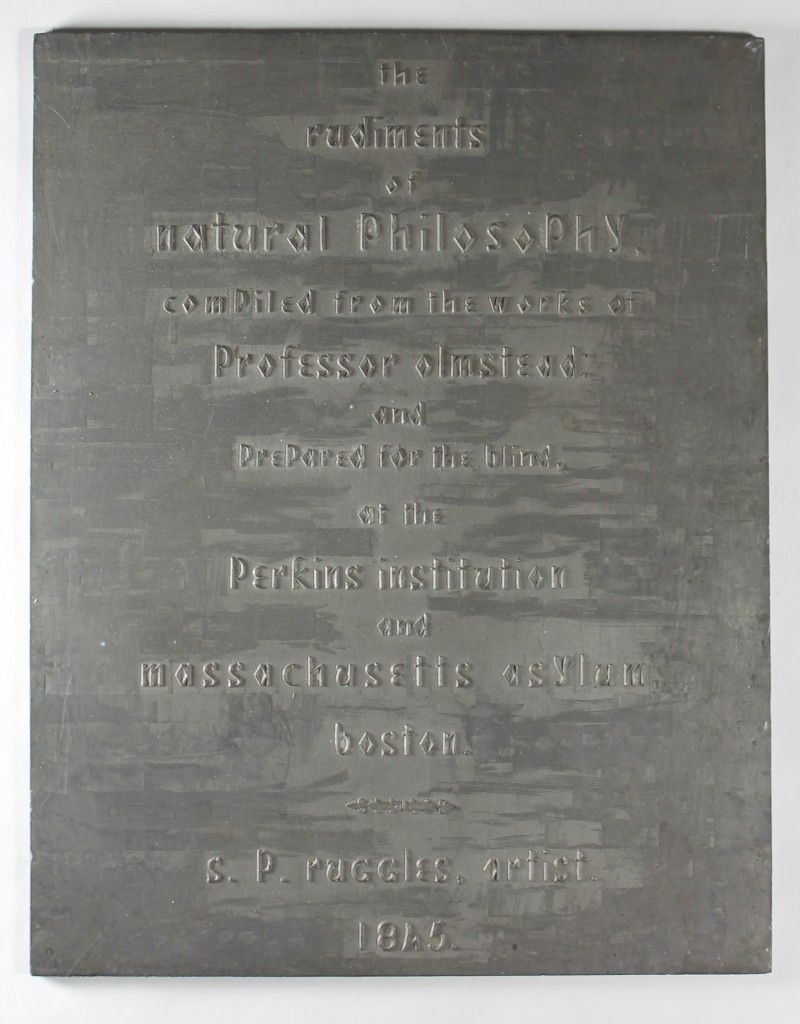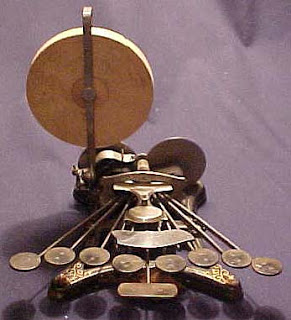As I studied the online Touching the Book exhibition, I was struck by how many of the books were printed in roman embossed types, even those published many decades after the invention of braille. Although Louis Braille published his writing system in 1829, it was not recognized as the official writing system for people who were blind in France until 1854.[1] British educators only began to endorse braille from 1870.[2]
In the U.S., embossed writing systems in roman script held sway for even longer than in Britain and Europe. Michael Anagnos was director of Perkins School for the Blind in Massachusetts, and one of the sighted educators who advocated for embossed alphabet writing systems. Nonetheless, in 1877 he wrote of braille, “This system has so many advantages that render it popular among the blind, that they would undoubtedly adopt it in preference to all others, if they were left free to make their own choice.”[3] What accounts for the reluctance to use a writing system that offered elegance, compactness, portability, and perhaps most important of all, the freedom to write?
In part, the tenacity of the embossed roman alphabets might be explained by the investment that was poured into them. The American Printing House for the Blind was established in Louisville, Kentucky, in 1858 by private backers who were committed to producing tactile books for readers who were blind. Materials in raised letters had been published by a few U.S. schools for the blind for more than 20 years, and the founders of APH did not seem to question the wisdom of continuing this practice. The agency produced materials exclusively in embossed roman alphabets until 1882, and didn’t cease publishing them until the 1920s.[4]
Sighted teachers sometimes claimed that they resisted arbitrary code systems like braille or New York Point because they “constituted an additional barrier between blind and sighted people.”[5] Writing about embossed roman alphabet systems in his essay, “War of the Dots,” Robert B. Irwin said, “… it was contended that the blind people, by using a type similar to that of their seeing associates, were set less apart from the rest of the world.”[6]
Perhaps sighted educators had a more compelling reason for resisting point systems. Many were simply unwilling to memorize a new set of symbols. Irwin puts this tactfully when he writes of embossed roman alphabets, “Their virtue as compared with arbitrary codes seemed to be that they could be read by sight by the seeing teachers with no special instruction.”
In spite of resistance to point systems, their benefits were undeniable. William Bell Wait, head of the New York Institution for the Blind, developed New York Point in 1871, and promoted it among educators prodigiously. In spite of its many drawbacks compared to the braille system, many schools adopted it. In 1882, the American Printing House for the Blind decided to devote half of their book production to New York Point.[7] Given the opinion of educators and the financial investment in non-braille writing systems, how did braille finally win acceptance as the writing system in the U.S.?
Braille came to the United States in 1860, when the Missouri School for the Blind introduced it into its curriculum. School Superintendent John Sibley wrote, “Children will master the ‘Braille’ in a few days, but many months and sometimes years of hard work result in a failure to learn the ‘Line Letter (embossed alphabet system).’”[8]Perkins was one of the headquarters of resistance to point systems, but only nine years later, the school was selling braille slates alongside its embossed books. How did braille so quickly find a place in an institution that championed Boston Line Type?
Although no other school officially adopted braille for decades, and the American Printing House did not produce braille materials until 1893,[9] the system was embraced by pupils at the schools for the blind. Compelled to read embossed alphabets or New York Point for study, the students were free to use braille for personal correspondence and notetaking (except at the Illinois school, which confiscated braille slates).[10] If their school would not teach them braille, the students apparently taught one another. I like to think that braille spread virally, with the Missouri school as the epicenter.
In the mid-1870s, a team of teachers and graduates at Perkins School for The Blind compared all the embossed and point writing systems, determined to identify the best. Braille was the unqualified winner. Perkins director Michael Anagnos wrote of braille, “The scientific ingenuity upon which its construction is based, renders it remarkably simple and methodical; and it is thereby easily acquired and remembered. The arrangement for musical notation is so systematic, so concise, and so comprehensive, that it can scarcely be equalled by any similar contrivance.”[11] Arising from the unequivocal findings of this comparative study, the school added braille into its curriculum for both reading and writing, without dropping its older methods.
Unable to leave well enough alone, Anagnos charged a brilliant and inventive teacher to improve upon the original code. Joel W. Smith reassigned the braille cells so that the most frequently used English letters were represented by the cells with the fewest dots. This Modified, or American, braille might have been a bit faster to read and write than Standard braille. Unfortunately, it introduced yet another writing system for students to learn, and another camp of bickering proponents in the increasingly contentious argument about the best writing system for readers who were blind.
In spite of the preference of readers for the clearly superior braille point system, Perkins incomprehensibly continued to publish its books in embossed alphabets for over 30 years more. The American Printing House for the Blind only ceased publishing in New York Point in the 1920s, when schools for the blind stopped teaching it. It was not until 1918 that Standard braille was selected as the official writing system for the U.S. After more than a decade of wrangling and disagreement with educators from Great Britain, a committee of educators settled upon Revised Braille Grade 1-1/2.
Nearly 60 years after its introduction into the U.S., braille was finally the official writing system for people who were blind. This success is attributable to its loyal users, who would not give braille up, even when attempts were made to supplant it or even to suppress it. I like to think that this is one of the first milestones in the beginnings of the disability rights movement.
Jan Seymour-Ford, Research Librarian, Perkins School for the Blind
[1] Pamela Lorimer, ‘Origins of Braille’, in Braille Into the Next Millennium (Washington, DC: National Library Service for the Blind and Physically Handicapped, and Friends of Libraries for Blind and Physically Handicapped Individuals in North America, 2000), p. 35.
[2] Lorimer, p. 36.
[3] Michael Anagnos, ‘Report of the Director’, in Forty-sixth Annual Report of the Trustees of the Perkins Institution and Massachusetts School for the Blind (Boston: Perkins Institution, 1878), p. 70.
[4] Carol Brenner Tobe, History in the Making: The Story of the American Printing House for the Blind 1858-2008 (Louisville, KY: Butler Books, 2008), p. 70.
[5] Lorimer, p. 36.
[6] Robert Irwin, ‘War of the Dots’ (1955), accessed online <http://www.nyise.org/blind/irwin2.htm>
[7] Tobe, History in the Making, p. 70.
[8] John T. Sibley, The Blind; Their Characteristics and Education: An Address Delivered in the Hall of the House of Representatives, at Jefferson City, Mo., February 26, 1891 (St. Louis, MO: Commercial Printing company, 1891), p. 16.
[9] Carol Tobe, ‘Embossed Printing in the United States’, in Braille Into the Next Millennium (Washington, DC: National Library Service for the Blind and Physically Handicapped, and Friends of Libraries for Blind and Physically Handicapped Individuals in North America, 2000), p.46.
[10] Irwin.
[11] Anagnos, p. 70.





